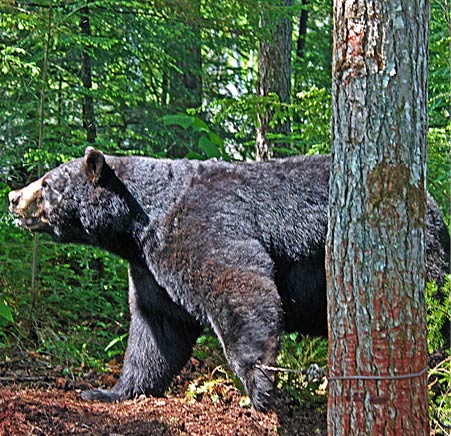Bear Trapping
To trap bears, Maine allows either a foot
snare or a cage-type trap. Steel-jawed
foot-hold traps are not legal.
Hunters and trappers use foot snares almost exclusively. A bear
cage trap is a big, expensive, metal culvert-type affair that has to
be moved by vehicle, while a foot snare can be easily carried in one
hand and costs about $50, and can be re-used indefinitely. The choice
is a no-brainer for most.
snare or a cage-type trap. Steel-jawed
foot-hold traps are not legal.
The foot snare is very humane, and does not damage the bear’s foot. The International Organization for Standardization (ISO), founded in 1947, is a highly respected organization with 164 member nations, and is the reference group for manufacturers globally. Using injury scores developed by veterinarians, in cooperation with animal welfare groups and wildlife biologists from many countries, ISO tested foot snares extensively. In the 1997 Agreement on International Humane Trapping Standards (AIHTS), ISO certified the foot snare as humane and acceptable for capturing animals without injury.
The foot snare uses a spring and trigger assembly to close a loop of 3/16-inch diameter smooth steel cable on a bear’s foot. The trigger is placed where a bear will step on it, and a 12-inch diameter loop of cable is laid on the ground around it. When the bear steps into the loop and onto the trigger, the spring is released, lifting the loop and closing it on the bear’s foot. A sliding one-way lock mechanism lets the loop close, but not open. A metal stop keeps the loop from closing tighter than 21⁄2 inches. This lets any cub bears, coyotes, raccoons, etc., escape.
The end of the cable opposite the loop is wrapped around a tree, and held in place by cable clamps. It is attached tightly enough so the bear can’t slide it up the tree by climbing, potentially hurting itself, but loose enough so it can rotate freely around the tree without twisting. Several heavy duty swivels in the cable prevent the bear from twisting it, and possibly injuring itself.
The bear can only go round and round the tree. Essentially, it’s on a leash.

Big Tank, a huge old male bear trapped several times through the years by Maine’s Bear Study program. This photo shows the foot snare at work, holding a bear without harm for research and release. This is the trap used by Maine bear trappers. It is completely humane. MDIFW photo
Maine’s nationally famous Bear Study has monitored
thousands of bears since it started in 1975. During that time,
using the foot snare, it has trapped and released, unharmed,
for research, over 2,700 bears. Many bears have been caught
repeatedly through the years, and have shown no physical or
behavioral trauma from the experience. Trapped bears don’t
struggle much, and are found sitting quietly at the trap
site, often sleeping. Their health and condition is closely
studied and examined by trained biologists, and trap injuries
are statistically non-existent. The bears have to be released
completely unharmed for the studies to be effective. Foot snares
would never be used if they damaged the animals even slightly.
The foot snares the Bear Study program uses are exactly the same traps used by recreational bear trappers. They do not cause pain or injury to the bear.
■
Bob Noonan,Freelance Writer, Editor, Publisher
Bob Noonan has published well over 1,000 articles in magazines ranging from Reader’s Digest to Down East, and numerous others. He has edited and published several outdoor magazines.
Home ● Bear Groceries ● Hunting with Bait ● Hunting without Bait ● Bear Trapping ● Effects of Bear Overpopulation ● Does Bait Increase Bear Numbers ● Does Bait Create Habituated Problem Bears
Bear Problems ● Dealing with Problem Bears ● Bears and the Maine Economy ● Other States that Banned Bait and Dogs ● Bear Predatory Behavior on Humans ● A Maine Predatory Bear Attack

